

Chemistry. Forces, Elements, & the Periodic Table. Quantum Mechanics. Mathematics, Systems, Complexity & Chaos. Nanoscience. String Theory. Physicist suggests speed of light might be slower than thought. God is on the ropes: The brilliant new science that has creationists and the Christian right terrified. Colourful Chemistry. List of unsolved problems in physics. Some of the major unsolved problems in physics are theoretical, meaning that existing theories seem incapable of explaining a certain observed phenomenon or experimental result.
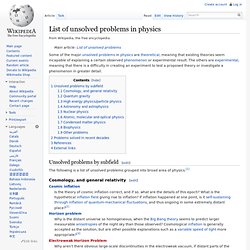
The others are experimental, meaning that there is a difficulty in creating an experiment to test a proposed theory or investigate a phenomenon in greater detail. Unsolved problems by subfield[edit] Thermometer measures temperature to 30 billionths of a degree. The thermometer is three times more accurate than current systemsIt works by circulating green and red light around a disc-shaped crystalAs the crystal heats up, the red light slows down compared to green lightBy forcing the light to circulate thousands of times, scientists can measure the difference in speed - and as a result temperature - with great precision By Ellie Zolfagharifard Published: 13:15 GMT, 2 June 2014 | Updated: 14:46 GMT, 2 June 2014.
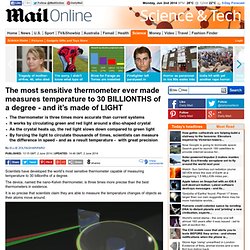
Oxford University scientists create a 'SUPERNOVA' in the lab. A team from Oxford University have recreated a supernova explosionThe experiment was performed with the UK's Vulcan laser facilityThey heated a rod to millions of degrees by focusing 3 laser beams on itThe rod then exploded into a surrounding gas, mimicking the interaction between a star going supernova and the interstellar mediumResults prove that supernovas do not expand uniformly as once thoughtCould also solve the mystery of how magnetic fields formed in the universe By Jonathan O'Callaghan Published: 11:24 GMT, 2 June 2014 | Updated: 14:34 GMT, 2 June 2014.

The physics of water drops and lift-off. The flow of fluids is one of the most complex, beautiful, and amazing things in physics.

Slow motion pictures of drops landing on water or of two fluids mixing can be simply gorgeous. Even more amazing, the basic physics of fluid flow was worked out way back in the 19th century. Those equations, though, hold riches that are still being uncovered today. Some of the most spectacular work in recent years has involved uncovering what happens as a drop of fluid hits a surface. And one particularly stubborn aspect—why do you get lift-off (a precursor to a splash) near the end of the impact? To splash or not to splash? Direction of Time Fuzzy for Subatomic Particles. Subatomic particles don't care if time moves forward or backward — it's all the same to them.

But now physicists have found proof of one theorized exception to this rule. Usually, time is symmetrical for particles, meaning events happen the same way if time progresses forward or backward. Spooky Entanglement, Antimatter & Nuclear Fusion. By Clara Moskowitz, LiveScience Senior Writer | February 18, 2011 08:55am ET Credit: Mark Dennis.
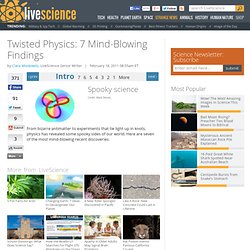
From bizarre antimatter to experiments that tie light up in knots, physics has revealed some spooky sides of our world. Here are seven of the most mind-blowing recent discoveries. Author Bio Clara Moskowitz. The Coolest Little Particles in Nature. Dreamy Images Reveal Beauty in Physics. Top 50 Physics Ideas: the principles that changed the world.
Physics. Watch the everyday Slinky 'defy' the laws of physics and gravity (but try not to go loopy) By Eddie Wrenn Published: 09:09 GMT, 22 June 2012 | Updated: 10:42 GMT, 22 June 2012 It's a childhood toy that we have probably all seen - but watch it in slow-motion, and the Slinky appears to defy the laws of physics.
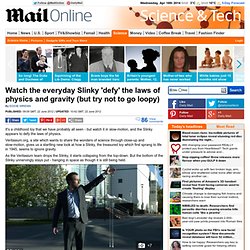
Veritasium.org, a site which wants to share the wonders of science through close-up and slow-motion, gives us a startling new look at how a Slinky, the treasured toy which first sprang to life in 1945, seems to ignore gravity. How the Modern Physics was invented in the 17th century, part 3: Why Galileo didn’t discover universal gravitation? Note: this is the third of three parts of the essay.

The first two parts were published yesterday and the day before (see links at the bottom of the page). The very first discovery in fundamental physics, made by Galileo, – the law of free fall – was also the first discovery in physics of gravity. It was the starting point for Newton’s law of universal gravitation a few decades later. Was it possible for Galileo himself to discover the law of universal gravitation at his level of mathematization and by his style of doing science? Yes it was, although Galileo’s predisposition was quite unfavorable, since he rejected statements on attraction as an explanation of the Solar system. Galileo is often reproached for his keeping to “backward” ideally circular planetary orbit despite the observational reality summarized in Kepler’s law of elliptical orbits. The secret molecular life of soap bubbles (1913) Nature can be extremely devious in the way it hides its secrets.

Sometimes the most remarkable and profound insights are staring us right in the face every day in the most mundane phenomena. For instance, we have all seen the spectacular colors that can appear in soap bubbles: Image from Microscopy-uk.org.uk, by Michael Reese Much. Borrowing his lovely images until I can produce my own! These colors are produced by optical interference, as we will discuss below; the “thin film optics” that creates bright colors in soap films also results in the bright colors of oil slicks. LHC antimatter anomaly hints at new physics - physics-math - 23 November 2011. Read full article Continue reading page |1|2 The Large Hadron Collider has turned up differences in how particles of matter and antimatter decay that the reigning standard model of physics may not be able to explain WE ARE here thanks to a curious imbalance in the universe.
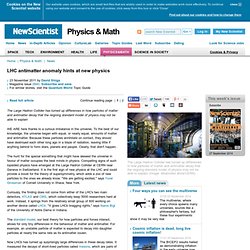
Animation reveals the world's hidden equations. MacGregor Campbell, contributor Although they don't actually exist in the physical world, our most powerful tools could be mathematical equations. They underlie much of modern technology, from radio to power generation, to photo compression and electronic musical instruments.
In our latest animated explainer, we look at how the wave equation, Maxwell's equations and the Fourier transform came to rule the modern world. To find out more, read our full-length feature, "Seven equations that rule your world". For more mathematics-related viewing check out our archive of One-Minute Mathvideos, or watch our previous animations to find out, for example, if supersymmetry could explain everything or why there is no such thing as empty space. Quantum Computers Will Solve Problems that would take Today's Computers Longer than the Age of the Universe. Astrophysicist Paul Davies at Arizona State University proposes that information, not mathematics, is the foundation on which physical reality, the laws of nature, are is constructed.
Meanwhile at MIT, computer scientist Seth Lloyd, develops Davies assumption, by treating quantum events as "quantum bits," or qubits, as the way whereby the universe "registers itself. " Lloyd proposes that information is a quantifiable physical value, as much as mass or motion -that any physical system--a river, you, the universe--is a quantum mechanical computer. Physicists Predict Properties of Prime Numbers from Freezing Liquids. Physicists from Queen Mary’s School of Mathematical Sciences, together with colleagues from Bristol University, discovered a pattern in frozen glasses that relates to prime numbers.
By building models and developing theories, the team believes they have evidence for a connection between prime numbers and freezing in certain complex materials in Physics. The same freezing which is responsible for transforming liquids into glasses can help to predict some patterns observed in prime numbers, according to a team of scientists from Queen Mary, University of London and Bristol University. At a low enough temperature, water freezes into ice by arranging its molecules into a very regular pattern called crystal. However many other liquids freeze not into crystals, but in much less regular structures called glasses – window glass being the most familiar example. The accidental universe: Science's crisis of faith—By Alan P. Lightman. Physicists observe the splitting of an electron inside a solid. Printer friendly version Share 18 April 2012 Paul Scherrer Institut (PSI)
Anonymous Donor Saves Last U.S. Particle Physics Lab From Going Under. Tiny 'Soccer Ball' Space Molecules Could Equal 10,000 Mount Everests. 'Faster Than Light' Neutrino Was Product of Loose Cable at CERN. The universe as we know it was saved today. Scientists capture first image of two atoms INSIDE a molecule (but we'll just have to take their word for it) By Rob Waugh. Welcome to Explorations in Science with Dr. Michio Kaku.